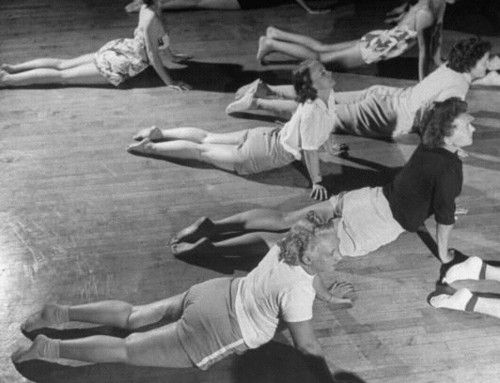Careening Down A Dangerous Path.
{Photo via Pinterest}
So, I’m perusing through my Facebook feed the other day and I see this post:
“Sometime soon, we may reach a point where half the women in America will be teaching Yoga to the other half…”
An interesting quip from a man I worked with at a California newspaper in the early 90’s. To my knowledge, he’s a PR executive and not a Yoga teacher. Hmm, even non-yogis realize things are out of control and there’s no end in sight.
I touched on this in late 2013 when I wrote an article that evoked much discussion in the Yoga community. My honest reflection resonated with many, ticked some off, and got people thinking.
So, here I am watching the snow fall outside my window in Massachusetts. It’s been about two years since I traveled to 40 cities in the US and Canada in the course of 15 months.
I got a realistic pulse of the Yoga landscape in America, and hit classes in strip malls, YMCAs, intimate settings, large chain studios, gyms, and pretty much every place in-between.
When I returned home, I reassessed where I wanted to go with my studio, Breathe Joy Yoga, which sits behind my house in the woods. After witnessing the state of the Yoga industry, I knew it was time for a change.
I was done operating a full-blown studio where part of the job was competing for Yoga newbies who are more concerned about sweating, low prices and convenience than immersing themselves in the practice. So, instead, I focus on teaching two to four classes a week at Breathe Joy Yoga.
Everyone is welcome and every class is engaging and unique as I never have a Yoga pose playlist prepared. I also oversee Pretzel Kids® trainings and classes, and I have returned to freelance journalism.
Once in a while, I offer PR and marketing consulting services to other Yoga professionals trying to navigate this rocky landscape.
So why revisit this topic? Well, because we’re no better off than we were two years ago. In fact, we’re much worse off. And this, my friends, affects how and where we practice Yoga, as well as the integrity of our community as a whole.
Today, I would guess 30-50% of Yoga studios offer 200-hour Yoga teacher trainings. It’s no surprise, as these courses generate fast cash and help pack studio classes.
Now, don’t get me wrong. Studio owners deserve to earn a living and hopping on the teacher training gravy train is a surefire way to ensure that they do so. There is nothing inherently wrong with this.
But, here’s the problem: As long as students continue to drink the Koolaid served at the closest Yoga studio, teacher trainings will multiply like bunnies in a highly unregulated industry. Seems a little harsh, I know. But let’s peel off some more layers here.
Yoga in America isn’t what it used to be, and we, as a Yoga community, should stand up in Tadasana and take notice. It was only 11 years ago when I opened Breathe Joy Yoga. I offered a comprehensive teacher training course as much out of need as desire. There were simply no programs in my area.
The market wasn’t saturated, and skilled Yoga teachers were in high demand.
Flash forward to today: If you throw a ball out of a window in any major US city, it will hit one Yoga teacher on the head and bounce onto another instructor’s asana. Taking classes and teaching Yoga is the in thing.
Many students wear rose-colored glasses and think that, if they become a Yoga teacher, they too can open a successful studio (just find an empty corner, start a Facebook page, and voila!) or at least teach a few classes a week (good luck finding a studio without a two-page list of subs).
The plot thickens. Many still think they can quit their day jobs and make big bucks teaching Yoga. Now, I know… some of you are thinking I sound cynical or this is just sour grapes.
But, let me tell you right here and now: I sure as heck don’t have sour grapes. I love to practice and teach Yoga. And, I enjoyed the challenge of turning a small, community-supported studio into a thriving business.
I wouldn’t have chosen any other life or livelihood for the eight years I ran a Yoga studio full-time.
Here’s another thing: I love that Yoga is now readily available. I just wish we were more responsible about this mushrooming growth.
One of the pitfalls of working and practicing in an unregulated industry is that many businesses offer Yoga classes and have no idea whether their own Yoga instructors are skilled. A certificate from a crash course is sometimes all a health club needs to hire a teacher.
It’s even become commonplace for prospective teachers to audition. Here’s a common scenario: A club owner sits through a slate of auditions and then, regardless of whether this casting director knows the difference between Yoga and Pilates, a Yoga teacher who fits the part is selected from the lot.
And then there are master classes. What defines a master class? Well, nothing really. At least not anymore.
Any newly-minted, recent 200-hour graduate can throw together a workshop and call it a master class. Scratch that. No 200-hour certificate is necessary as anyone can teach a master class.
It certainly sounds impressive and many students take the bait, especially when they see this so-called expert on Instagram striking a perfect pose. Our industry has run amuck here.
In my opinion, there are only a small handful of teachers who should be considered masters in any field. Yoga is no exception.
About now I’m probably pissing off some of you. But, put your egos aside for a moment. I’m saying it like it is. Satya for ya in its truest sense.
To that end, I’m going to tell you a story that may help illustrate where our industry is headed. I’m warning you: it’s a doozy.
A couple of months ago I received a pitch for a workshop from an out-of-town teacher whom I had never met.
I usually only offer workshops taught by experienced teachers I know. This way, I feel comfortable about what I’m selling, and confident that my students will take away something valuable from their time and financial investment. But, it sounded good, so I decided to give it a go.
The teacher sent me a description of the workshop for beginners, which would include backbends, arm balances and inversions. She then explained that the inversions would encompass variations of headstand, shoulder stand and maybe handstand.
Further information indicated her method will help students reach happiness faster. Okay. Let’s stop right there. Reach happiness faster? By doing a headstand? Wow. Now you really got me going.
Call me crazy. Call me responsible. I don’t care. I had to put my foot down and question her proposal. Here’s our email chain:
The teacher: “Regarding inversions, I am skillfully trained to teach them in a very safe and attentive way.
I realize that not a lot of instructors feel comfortable teaching them (and thus they go untaught which I believe is a shame), but I feel that if proper alignment is taught, modifications are given and safety precautions are taken, inversions are not only extremely beneficial but tangible to even the most beginner of yogis.
(insert here this teacher’s style, purposefully left out) places a strong focus on inversions and without them, I wouldn’t stay true to its homage…”
I agree that inversions are beneficial, however, kicking our egos to the curb: Even with modifications and the best instructor in the world, my experience is that it’s impossible to watch everyone at the same time in a large room filled with upside-down beginners who you don’t know.
I was getting squeamish just thinking about the possibility of someone falling over on my hardwood floor. I also wasn’t feeling too warm and fuzzy about a teacher who felt that, without teaching specific inversions, she was not staying true to her Yoga lineage.
I mean, c’mon, really? Aren’t there plenty of other asana choices out there? Um, yes.
Here’s how it ended peacefully as I was willing to give her the benefit of the doubt:
Me: “So, here is my position: From a liability perspective, I feel it’s not responsible or safe for me to offer this at my studio. I understand that you would prefer to stay true to your homage but I need to stay true to safety and health.
Are you able to offer rabbit pose, basic tripod and/or modified shoulder stand with legs up in an L (like legs up the wall without the wall) as alternatives? Let me know your thoughts. Thanks again.”
She wrote back: “I understand your concerns. Yet on the other hand I ‘respectively’ [sic] disagree.”
That was that.
So let’s talk a little about homage and lineage. What does that even mean? Back in the heyday (meaning hundreds and even thousands of years ago — long before Lululemon pants graced our Yoga classes), Yoga teachers were taught by true experts to pass down this ancient tradition.
Take my primary teacher, Diane Lagadec. Diane is the real deal. About to turn 71, Diane runs Maha Yoga Center in Bridgewater, MA, and you can often find her in a safe backbend or inversion.
She trained with Shri Khanna, who was one of the yogis who came to the states in the late 60’s and early 70’s to learn and teach.
“He came to Boston to complete a doctorate, and while he was here, he created a small ashram in a home in West Newton. He was friends with Yogi Desai, Dr. Mishra (also known as Swami Brahmananda Sarasvati), etc. We got to meet and learn from wonderful teachers.
Shri was from the Maha Ananda Ashram in Simla, India. I studied with him for years,” said Diane.
I realize there’s no one path to anything, but I am fairly certain that enrolling in a 200-hour teacher training for a handful of weekends or taking classes in a hyped-up studio with packed classes and hotshot teachers is not going to help you reach nirvana faster.
What to do? For starters, do your research.
If you practice Yoga, inquire of yourself: Why am I choosing this teacher to guide me? Maybe you have no idea whether he/she is skilled. Maybe the time works for your schedule. Maybe the quality or safety of the class doesn’t matter to you. You still should ask.
If you’re considering enrolling in a teacher training, ask yourself: Why do I want to take this course with these teachers at this studio?
If you’re a Yoga teacher or studio owner, ask yourself: Why do I want to teach? Why do I want to run a 200-hour course? There is no right or wrong answer.
The point is: We should all be digging deep. Or, as we yogis say, it’s time to practice self-study, a.k.a. Svadhyaya.
I may be going out on a limb here, but we are careening down a dangerous path. Literally. Yoga students are blowing out hips and shoulders regularly. I’m thinking Patanjali didn’t have this in mind. Take a look at the Yoga Sutras.
Depending on your interpretation, only about five of the 196 sutras (II: 29 and II: 46-49) discuss anything to do with asana. Let’s sit on that for a while.


